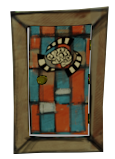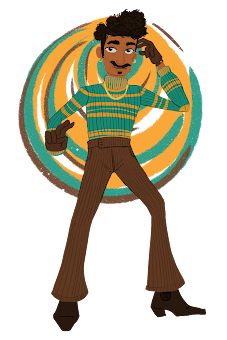I'm Justin, the guest blogger of the month here on the Official SCBWI Blog!
About me:
I love mixing visual and performance art, inspired by my background in dance, movement, and theater. I strive to write stories that explore and celebrate the interconnectivity, imperfection, and uniqueness of BIPOC people while challenging stereotypes and narrow constructions of identity, gender norms, and stigmatization of queerness.
Graduate of Montclair State University with a BFA in Dance and a Minor in Art Studio & Design (Illustration), I now perform professionally, nationally, and internationally.
For more information about my performance career, visit www.justincampbellnyc.com.
Oh! Also, I am a merman!
So before we dive into today’s topic, I’d like to share a quick story.
As a kid, my cousins and I would play video games NON-STOP all summer, with our trip to Blockbuster (R.I.P.) being a highlight of our week. Every week, we would rotate who chose a game as there were four boys with four very distinct tastes in media—I liked RPGs and Fantasy over my cousin’s choices of FIFA and WWE.
On one of my turns, I discovered this game with an extremely cool cover and decided to rent it. It has now become one of my favorite games of all time!
It is a psychedelic, weird, hilarious game that follows the story of a young kid with psychic powers. Away at camp to hone his skills, strange things begin to happen to the campers. With awesome storylines and gameplay to match, one of my favorite concepts/features is how you enter each level.
There are these tiny doors, you see.
To this day, I visualize this when I meet new people that I want to connect with and understand.
And most days, as I am ALWAYS in my head, I try to imagine what the "playable level" would look like in my mind as a person of systems, lists, and colorful tabs.
So today, Psychonauts will be my inspiration as I map through my CREATIVE mind!
I love learning, and I like being walked THROUGH a process to establish pathways in my brain. Then, from there, I can adjust, create, and combine styles, techniques, and information to develop my own process.
So let’s jump into my MIIINNNNNDDDD!
Let's start where we left off, shall we? After all of the work I did to collect, generate, and figure out a catalog/library of subjects and styles I liked back in Blog #2, I began to apply this knowledge!
As a student at heart, I began to research the process of other artists, scouring YouTube, Instagram, and TikTok, to find processes that spoke to me.
I am a big lover of Domestika's online courses, and one of the first lessons I took was Illustrated Stories: From Idea to Paper by Alfredo Cáceres.
During this course, Alfredo walked us through his process, which I boiled down to four steps: "Craft the Idea," Setting, Symbols, and Color Ideas.
Alfredo read an excerpt from “The Black Sheep” by Italo Calvino, a story about an honest man who brings down a society of thieves. From there, Alfredo broke the story down into a select number of characters and images:
The thief, the house, and the honest man.
Then, Alfredo illustrated these prompts to whittle them down to clear/concise images, made thumbnails for his composition, and, eventually, traditionally painted the final illustration. I sketched my prompts traditionally, and I adapted the rest to digital for my final drawing. I respond well to words as well, so I combined these drawing steps with writing and stream-of-consciousness exercises.
Here are the steps I follow!
01: “Craft the Idea”
At this stage, I think of stories to draw ideas from. They can be familiar, like fairytales/folklore or original “stories” or concepts I’ve whipped up in my mind.
For example, for Hans Christian Andersen’s “The Little Mermaid,” I listed: The mermaid, the Prince, the Sea Witch, the dagger, dawn, human stuff, treasure, two worlds, longing, the Statue of Prince, the human world, ornate, Indigenous, sunrise
Once you generated your list, choose three to four concepts to focus on. I chose Prince, Mermaid, Sunrise, and Two Worlds. From there, I sketched from those image/character prompts. Don’t get caught up in the details at this point. Just doodle!
02: “Setting/ The Set”
Next, I listed some potential locations:
-the ocean, the shore, the castle, underwater, underwater garden, outside, water's edge
I liked the idea of the castle, but I also wanted to show some underwater scenes, so I began to think of interesting ways to combine the two.
At this point, I even thought of regions in the world like North Africa, East Africa, and the Middle East, and I landed on the Philippines as my inspiration.
I ended up setting the period at the turn of the century so I could explore the connection between the Indigenous Philippines and the Westernization of the culture in a potentially longer project. Thank you to my Filipina friend for guiding me and fact-checking! Love you, girl!
03: “Symbols”
From here, I listed symbols that I could use to convey and communicate what I wanted. Very similar to “Crafting the Idea,” this step is to sharpen the theme with visual indicators to elevate the story being told. As they say, a picture is worth a thousand words.
Here are some specifics I wrote: mermaids, bubbles, dagger, ocean, castle, seashells, statues, waves
Next, I sketch the thumbnails! I sketch in ink so I don't get caught up in the detailing!
I decided to compose a scene where the Mermaid is fleeing the wedding of the Prince, who has sealed her fate by marrying another. She runs to the water to become sea foam as the Prince tries to stop her. All the feels, all the drammmmmaaaa!
To incorporate the ocean, as the Mermaid touches the water at the base of the stairs, a seascape emerges, revealing her tail and what her life looked like. Above are some thumbnails where I tried to work out different layouts.
“Color Ideas”
During this step, I introduce principles I’ve learned about color theory throughout my studies. Here are two videos that helped me as I sat at my dining table, pulling my hair out over color palettes. I revisit these videos frequently, and they keep me on track.At the SCBWI Winter 2024 Conference, I attended Sailing Through the Sea of Colors: Unleash the Thrilling Potential of Color to Supercharge Your Storytelling, presented by Cátia Chien.
.jpg) In this workshop, Catia broke down her process for choosing colors for her picture books. As I aspire to create children’s books, I blended some of her teachings into my process.
In this workshop, Catia broke down her process for choosing colors for her picture books. As I aspire to create children’s books, I blended some of her teachings into my process. She guided us through the concepts of Color Psychology and Color Theory and how they can be used in the emotional arc of your story, the “Color Script”.
 She used Pixar’s Color Mapping as an example to demonstrate how color can manipulate the viewer’s mood through a scene and how color associations affect the audience.
She used Pixar’s Color Mapping as an example to demonstrate how color can manipulate the viewer’s mood through a scene and how color associations affect the audience.Whether I am choosing colors for an illustration, a character, or a moment in a story, I keep account of the psychological aspect presented by Catia.
Pink for romantic feels/sunrise
Blue for the ocean (obviously) but also, melancholy and loneliness.
Coral for a variation of romance but tied to the ocean theme.
Orange and yellow for sunrise but energy, propelling the story to what is to come.
In my thought process, on top of showing the contrast between nighttime and sunrise, I wanted the blue to accentuate this feeling of sadness/longing as she runs back to the ocean where the warm light of pink, and yellow beckons her.
The coral of her tail and the pale version of her dress were chosen to represent romance but also her connection to the ocean and how on land, her "mermaid-ness" is duller.
The circular composition was to draw the viewer's eye down, around, and over from the sunrise/Mermaid past her tail and to the Prince who directs your eye back to the Mermaid.
An endless cycle of longing and unrequited love.
When it comes to longer projects, like storyboarding or picture bookmaking, I like to use the principles below to help develop the story, mood, and emotional arc.
Phew! This was a long one, but I hope it was helpful! I have all of these steps on my wall above my art table as a guide for my brain! Map out your process. Keep it close at hand. Let it guide you through with tools to create!
For more about me, check out my illustrations HERE and follow me on Instagram @themermancam and on Bluesky!
Thanks, ya'll!















No comments:
Post a Comment